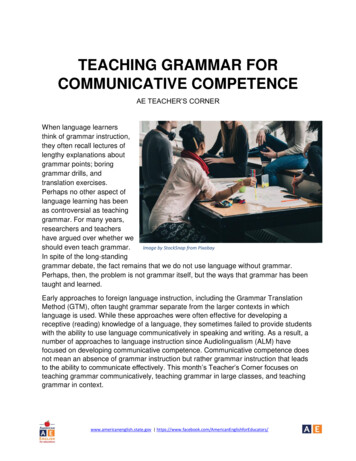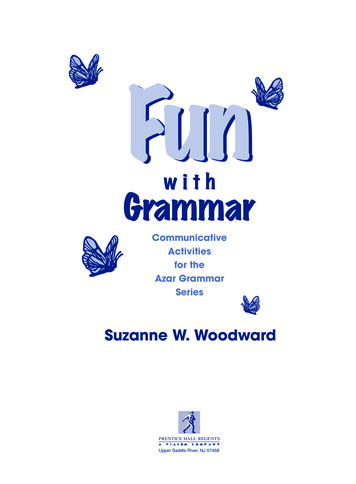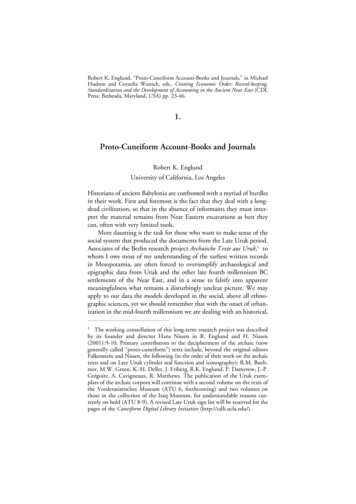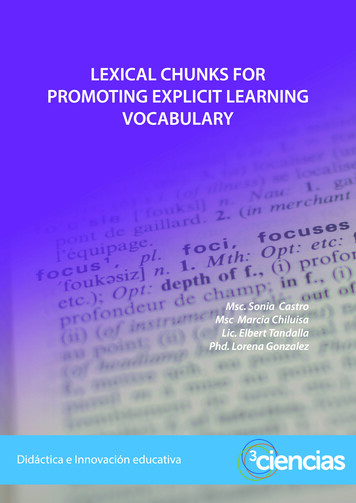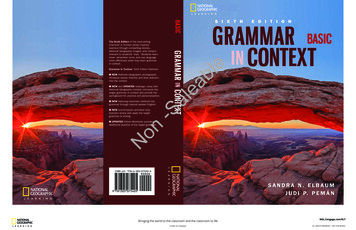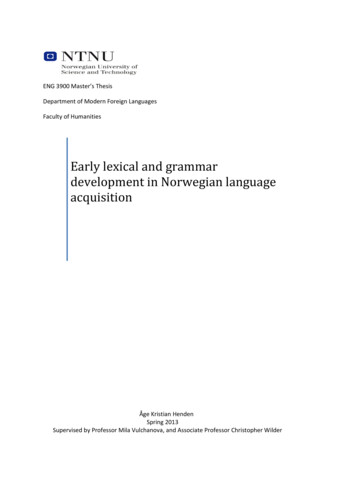
Transcription
ENG 3900 Master’s ThesisDepartment of Modern Foreign LanguagesFaculty of HumanitiesEarly lexical and grammardevelopment in Norwegian languageacquisitionÅge Kristian HendenSpring 2013Supervised by Professor Mila Vulchanova, and Associate Professor Christopher Wilder
Acknowledgements:I need to express my heartfelt gratitude to my supervisors, without whom this thesiswould never have been written. Assoc. Prof. Christopher Wilder opened my eyes to thefascinating world of grammar, and Prof. Mila Vulchanova was the first to awaken myinterest in language acquisition. This is why it has been a privilege to have you both as mysupervisors.There are six other people critical for this study. I am of course referring to the childrenand their parents. I thank you for allowing me to not only study your beautiful children, butalso for helping me do this. And thank you S and JK for talking into “fonen” (the telephone)I also have to thank Silje Nes Skrede for helping me navigate the rules and regulations.You have been of tremendous help, and a fountain of knowledge.My Junior High English teacher, Lise Rønnestad, deserves a lot of credit for making meinterested in the English language. Her enthusiasm, competence and hunger for knowledgeinspire me to this very day.Last, I have to thank my loving parents for their continuous support, and for encouragingme to find my own way in the academic jungle.2
I dedicate this study to the following:S and JK: do not grow up too fastMy beautiful nephewMy loving parents3
Table of ContentsList of abbreviations:. 7Abstract: . 81.Introduction . 91.1.2.3.The link between grammar and vocabulary . 132.1.The similarity between 20 month vocabulary and 28 month MLU . 132.2.Vocabulary size and grammatical complexity . 142.3.The Norwegian study . 16Methodology. 193.1.Measuring language development . 193.2.CDI . 193.2.1.Development of the Norwegian CDI form . 213.2.2.Validity and utility of the CDI . 223.2.3.CDI and vocabulary . 233.3.Mean Length of Utterance . 243.3.1.English vs. Norwegian syntax . 263.3.2.Verbs in Bokmål . 283.3.3.Auxiliary Verbs . 313.3.4.Nouns: plurality, gender and definiteness . 323.3.5.Nouns: possessive -s . 363.3.6.Adjectives . 373.3.7.Determiners . 403.3.8.Written Bokmål vs. spoken Nordfjord dialect. 433.3.9.Verbs . 433.3.10.Nouns . 443.3.11.Adjectives . 453.3.12.Nordfjord dialect vs. Bokmål conclusion . 453.3.13.The protocol for calculating Norwegian MLU values . 463.4.4.Scope of the present study . 9Method . 48Results . 514.1.The productive CDI results . 524.1.1.JK’s productive CDI results . 524
4.1.2.S’s productive CDI results. 534.1.3.Comparison between S and JK s productive CDI scores. . 534.1.4.Z-scores for S and JK. 544.1.5.The combined productive and comprehension scores . 554.2.4.2.1.Explanation to age equivalents . 584.2.2.JK s MLU results . 584.2.3.S s MLU results . 594.2.4.Comparison between S and JK s MLU results . 604.3.5.MLU results . 56Comparison between the CDI and MLU results . 604.3.1.S’s MLU and CDI . 614.3.2.JK’s MLU and CDI. 614.3.3.Comparison and discussion of the results. . 62Conclusion . 675.1.Conclusion . 675.2.Suggestion for further work . 68Literature: . 71Figure 1: Sentence complexity as a function of vocabulary size for Italian and English toddlers(Caselli, Casadio, and Bates, 1997; as cited in Bates and Goodman, 1997) . 14Figure 2: Grammatical complexity as a function of vocabulary level for the cross-sectional versuslongitudinal samples (Bates and Goodman, 1997) . 15Figure 3: Vocabulary as function of age, Norwegian results . 17Figure 4: Grammatical complexity as function of age, Norwegian . 17Table 3-1 Brown s rules for calculating Mean Length of Utterance (Brown, 1973) . 25Table 3-2 Johnson s protocol for calculating MLU (Johnson, 2005) . 27Table 3-3 Weak verbs. 28Table 3-4 Strong verbs . 30Table 3-5 Auxiliary verbs . 31Table 3-6 Nouns: gender, definiteness, and plurality . 34Table 3-7 Adjectives: Main pattern of inflection . 37Table 3-8 Adjectives : Superlative and Comparative forms . 40Table 3-9 Determinatives: Possessive pronouns . 42Table 3-10 Protocol for calculating MLU, adjusted to be applicable to Norwegian . 47Table 4-1 JK s productive CDI results and Norwegian/National and American norms for girls . 525
Table 4-2 S s productive CDI results and Norwegian/national and American norms for boys . 52Table 4-3 JK s z-scores . 54Table 4-4 S s z-scores . 54Table 4-5 JK s combined scores . 55Table 4-6 S s combined scores . 55Table 4-7 MLU results . 57Table 4-8 Age equivalents . 57Table 4-9 S s MLU and CDI . 60Table 4-10 JK s MLU and CDI . 616
List of abbreviations:CDIMCDICommunicative Development InventoryMacArthur –Bates Communicative DevelopmentInventoriesMean Length of UtteranceBoy in studyGirl in studyMLUSJK7
Abstract:This study was a case study of two monolingual Norwegian children S and JK. Both childrenare born and raised in the same area, by parents with similar academic and economicbackgrounds. S was 21 months old at the onset of the study, and JK was 20 months old.Their vocabulary development was measured on the Norwegian CDI developed byKristoffersen et al. (2012), MLU was used in order to track their grammatical development.Their language development was tracked between May 2012 and June 2012.The aim of the study was to compare their development in vocabulary size andgrammatical proficiency to determine whether a link between grammar and vocabulary, asproposed by Bates and Goodman (1997), can be found in Norwegian. Part of the aim wasalso to develop a Norwegian MLU protocol.An analysis of the results indicated that a link between grammar and vocabulary sizeexists in Norwegian, and that using the proposed MLU protocol gives valid results. Thissuggests that Bates and Goodman’s (1997) claimed link between grammar and vocabularysize might be a cross-linguistic phenomenon, but data from more languages need to beanalysed in order to determine this.8
1.IntroductionWhile adults learning a new language have a working knowledge of at least onelanguage, children have to not only learn words, but also learn what those words refer to. ANorwegian adult can link the concept behind the English word car to the Norwegiansynonym bil. A child cannot do this, and needs to not only learn the word car but also figureout what concept or entity the word refers to. In addition, a child acquiring language at atypical rate will be able to correctly use the morphology and syntax of the language he isacquiring at approximately 3 to 3.5 years of age (Bates and Goodman, 1998).Children’s ability to acquire language so fast and seemingly effortlessly fascinateslinguists all over the world (Karmiloff and Karmiloff-Smith, 2002). After the middle of thelast century a lot of research has been conducted in the field of language acquisitionattempting to find out how children manages this incredible feat (e.g., Dale and Fenson,1996; Bates and Goodman, 1997; Bates and Goodman, 1997; Brown, 1973; Dale andGoodman, 2005; Fenson et al., 2000; Miller, 1981). Despite this, there has been littleresearch in the field concerning Norwegian language acquisition, though Kristoffersen et al.(2012) recently conducted a large CDI norming study. In order to do this, they developed aNorwegian CDI form, opening the door for other researchers into early Norwegian languageacquisition.1.1.Scope of the present studyThe present study conducts a longitudinal study of two monolingual children acquiringtheir first language. S is the oldest, being 21 months at the onset of the study, while JK is afull month younger being 20 months at the onset. The children have similar backgrounds, asthey grow up in the same area, they both attend kindergarten, and their parents have verysimilar academic backgrounds.The aim of the study is to determine if the link between grammar and vocabulary sizeproposed by Bates and Goodman (1997) also exists in Norwegian. In order to do this, the9
children’s development in vocabulary will be tracked and compared to both the NorwegianCDI norms (Kristoffersen et al., 2012) and the American CDI norms (Dale and Fenson 1996).Their grammatical development is tracked by MLU, and an attempt is made to develop aNorwegian MLU protocol in order to do this. As there is no database with Norwegian MLUnorms, the MLU results are compared to each other, and to Miller’s age equivalents (1981).Miller’s age equivalents (1981) are for English though, so the connection between thechildren’s results and Miller’s age equivalents (1981) are tangible at best. It does give anindication of the validity of the results, as it is improbable that the Norwegian children areyears ahead or behind their English counterparts.It is generally accepted that in order to become a grammatical being, a child first needsto acquire a suitably large vocabulary (Karmiloff and Karmiloff-Smith, 2002; Kit, 2003). It isalso generally accepted that children start combining words when they are approximately18-20 months old. Shortly after this, grammar develops at an accelerated rate (Goodman,1995;Brown 1973). Therefore, it made sense to start compiling data for vocabulary andgrammatical development when JK and S were 20 and 21 months old. The study lasted fromJanuary 2012 to June 2012.This study is significant as it tries to determine whether the link between grammarand vocabulary, as found in English by Bates and Goodman (1997) and in Italian by Caselli,Casadio and Bates (1997), exists in Norwegian language acquisition. If the link is found, thisindicates that Bates and Goodman’s proposed link can be a cross-linguistic hypothesis. Thestudy is also significant with regards to the proposed MLU protocol. If the proposedNorwegian protocol works, it would enable researchers to use the same Norwegian specificprotocol to measure grammar development, and to find the Norwegian MLU norms. Even ifthe protocol does not work, it is still a significant step in the direction of developing aworking protocol.As this study is inspired by the findings of Bates and Goodman’s article “On theinseparability of grammar and the lexicon: evidence from acquisition, aphasia and real-timeprocessing” (1997), this article will be discussed in chapter 2. There will also be a brief10
presentation of the results from the study conducted by Kristoffersen et al. (2012) in thischapter.In chapter 3, the methods for collecting vocabulary and grammar data used in this studywill be discussed. A detailed analyzes on how Norwegian nominal and verbal inflectionalaffixation differs from English is made in order to determine what adjustments need to bemade to Johnson’s MLU protocol (2005) in order to make it viable for measuring NorwegianMLU.In chapters 4 and 5, the results are presented, discussed, and the study is concluded.11
12
2.The link between grammar and vocabularyThe goal of this thesis is to determine if the link described between grammar andvocabulary, as found by Bates and Goodman (1997) for American English, also is present inthe Norwegian language. This chapter is therefore primarily dedicated to presenting anddiscussing the evidence they put forth in their paper “On the inseparability of grammar andthe lexicon: evidence from acquisition, aphasia and real-time processing” (Bates andGoodman, 1997). The focus will be on the evidence they gained from acquisition, as thecurrent study is a study in the field of Norwegian language acquisition. The following datawere obtained from toddlers no younger than 16 months, and no older than 30 months.Elizabeth Bates was, and Judith Goodman still is, very well known and respected in thelinguist community as experts on early language acquisition. Their combined body of work inthe field of early language acquisition is impressive indeed, and Bates in particularcontributed greatly to the CDI form discussed in chapter 3. Bates and Goodman thereforespeak with a great deal of authority on the subject of language acquisition, and this is whytheir paper inspired, and was chosen to be the basis of, the present study.The results from Kristoffersen et al. (2012) study are also of great interest. Theirresults will also be presented and discussed in order to see if their findings are in line withBates and Goodman’s findings.2.1.The similarity between 20 month vocabulary and 28 month MLUThe first evidence Bates and Goodman (1997) present in their paper for the view thatgrammatical development and vocabulary size are linked, is the similarity between 20month vocabulary, and the 28-month grammatical status, measured by MLU. In alongitudinal study measuring the development of both vocabulary and grammar, where thegrammatical status was measured by MLU, they had some very interesting results. Whatthey found was that the vocabulary size at 20 months was a very good predictor for thegrammatical status at 28 months (Bates and Goodman, 1997). These findings indicate quitestrongly that vocabulary size and grammatical development are linked somehow.13
2.2.Vocabulary size and grammatical complexityFigure 1 below shows the results of cross-sectional studies into the relationshipbetween vocabulary size and grammatical development both for Italian toddlers, and forEnglish toddlers (Caselli, Casadio, and Bates, 1997; as cited in Bates and Goodman, 1997).Figure 2 below show a comparison between the English results of a longitudinal study (Batesand Goodman, 1997) and the cross-sectional study from Figure 1 in the same field.Figure 1: Sentence complexity as a function of vocabulary size for Italian and English toddlers (Caselli, Casadio, andBates, 1997; as cited in Bates and Goodman, 1997)14
Figure 2: Grammatical complexity as a function of vocabulary level for the cross-sectional versus longitudinal samples(Bates and Goodman, 1997)The non-linear graphs in Figure 1 are very similar, despite the fact that one graphdisplays data from English toddlers, and the other graph displays data form Italian toddlers.These results indicate that one can expect quite similar grammatical complexity from Italianand English toddlers at the same vocabulary level (Bates and Goodman, 1997). When thegraphs are so similar, it is logical to assume that the English and Italian functions linkinggrammatical complexity and vocabulary size are quite similar. This is quite surprising, asItalian grammar and English grammar are quite different (Bates and Goodman, 1997). Butwhile finding that the link exists in two different languages indicates that this is not alanguage specific phenomenon, data from other languages will have to be compiled in orderto determine if this can be said to be a general cross-linguistic phenomenon (Bates andGoodman, 1997). It will therefore be very interesting to see if the results of the Norwegianchildren in this study indicate a similar relationship between grammar and vocabulary size.The graphs in Figure 2 are also quite similar, though on average the results from thecross-sectional study are higher on the grammatical complexity axis than the results fromthe longitudinal study (Bates and Goodman, 1997). On the other hand, the graphrepresenting the results from the longitudinal study shows a higher increase in grammatical15
complexity from the vocabulary sizes 401-500 to 600. At vocabulary size 600, both graphsare at approximately the same grammatical complexity, though this might be a result of thefinite numbers of items in the CDI.While the graphs in figures 1 and 2 are not identical, they indicate that there is astrong link between grammatical proficiency and vocabulary size (Bates and Goodman,1997) both in Italian and in English. A comparison between the results from a late talker andan early talker further supports this, as their grammatical complexity scores are quite similarwhen the late talker has a vocabulary of 272 words, and the early talker had a vocabulary of315 words (Bates and Goodman, 1997). This also suggests that vocabulary size is moreimportant than age for grammar development, as the late talker was older than the earlytalker was when they had similar complexity scores.2.3.The Norwegian studyWhile Kristoffersen et al. (2012), did not present their grammatical complexity as afunction of vocabulary size, they did present both vocabulary size and grammaticalcomplexity as a function of age. Figure 3 shows vocabulary size and development as afunction of age. Antall ord on the y-axis is the same as ‘number of words’ and alder inmåneder on the x-axis is the same as ‘age in months’. In figure 4, the Y-axis display antallkomplekse former ‘grammatical complexity’ and the x-axis still display age in months. Bothfigures display the development for age groups 18-36 months. Figure 3 and 4 are fromKristoffersen et al. (2012).16
Figure 3: Vocabulary as function of age, Norwegian resultsFigure 4: Grammatical complexity as function of age, NorwegianWorth noting that the blue graph is the results for boys, and the red graph isthe results for boys at the 50th percentile in both figure 3 and 4. In both figures, the resultsfor boys are lower than the results for girls, though the graphs are relatively similar. EvenThough the results for boys are lower, at 36 months they are quite similar, both forvocabulary and for complexity, to the girls’ results. It is very interesting with the regards ofthe aim of the present study, to see that when there is a reported drop in the vocabularybetween 28 and 29 months for girls, there is also reported a drop in complexity. The same isfound between months 32 and 33. Between months 23 and 24 a small decrease in17
vocabulary is reported to have occurred, but a decrease is not reported in the complexitygraph for the same period. It is, however, reported that the complexity score for 24 monthswas the same as the complexity score for the preceding month.Between the months 29-30, the vocabulary and complexity graphs for boys also godown, but at months 32-33, the vocabulary is reported to stay the same, while complexitydecreases significantly. Overall, the results for boys and girls indicate that there is a linkbetween grammar and vocabulary in Norwegian acquisition, at least for young children inthe age group 16-36 months. This because boys are reported to consistently be below girlsboth when it come to vocabulary size and complexity, and because complexity seeminglyincreases or decreases at times when an increase or decrease is reported for vocabulary.The graphic representations in figure 3 and 4 do not allow us to comment on the strength ofthis link, however.The data displayed in the figures were collected by using CDI forms. Caselli andCasadio (1995) developed an Italian version, and this form was used to collect the data fromItalian toddlers displayed in Figure 1. Kristoffersen et al., (2012) developed the NorwegianCDI form used to collect the data displayed in figures 3 and 4. The CDI form will be used totrack the vocabulary development of the Norwegian children in this thesis, and will bediscussed in detail in chapter 3.The results indicate that a link between grammar and vocabulary size exists in bothEnglish (Bates and Goodman, 1997) and Italian (Caselli, Casadio, and Bates, 1997), and to acertain degree also in Norwegian (Kristoffersen et al., 2012).18
3.Methodology3.1. Measuring language developmentBeing able to accurately measure the language development of JK and S is crucial inorder to determine the effect, if any, the increase in vocabulary has on the grammaticaldevelopment of these children. In order to determine this, it is important to track both thevocabulary development and the grammatical development of the two children.Furthermore, as the children live far from any language labs and high tech language trackingequipment, it is crucial that the measuring methods are relatively low-tech, at mostrequiring access to a computer. But while the measuring methods have to be low-tech, theyalso have to be able to yield accurate data that can be compared to the development ofother children, and more specifically the findings of Bates and Goodman (1997).Fortunately, two very good measuring methods that fit these criteria are available,and one can track developments in the vocabulary, while the other can be used to trackgrammatical development. The first method is known as the MacArthur-BatesCommunicative Development Inventories, or CDI, and the second method is known as MeanLength of Utterance, or MLU. These measuring methods will be discussed in the firstportions of this chapter.As the children in this case study is acquiring Norwegian, and not English, acomparison between English and Norwegian syntax is made in the subchapter dedicated toMLU, in an attempt to create a Norwegian protocol for calculating MLU.3.2.CDIOne method often used to assess vocabulary development in children is the MacArthurBates Communicative Development Inventories, also referred to as CDI or MCDI. This is apractical and cost effective tool that does not require the user to have access to high-techcomputer software and/or high-tech equipment (Dale and Goodman, 2005).19
The MacArthur-Bates Communicative Development Inventories is a parentalquestionnaire developed by Larry Fenson and colleagues, and it was developed from diarystudies, a form of parental report used earlier (Dale and Goodman, 2005; Karmiloff andKarmiloff-Smith, 2002). Elisabeth Bates’ extensive research and use of the MacArthurCommunicative Development Inventories has led to the current form of the much usedquestionnaire, and the questionnaire used in studies these days is known as the MacArthurBates Communicative Development Inventories (Dale and Goodman, 2005). It is alsonoteworthy that Bates was among Fenson’s colleagues during the development of theMCDI.As the language development in children is quite rapid, there are actually two CDIquestionnaires. The one that is relevant for the children in this study is the CDI: Words andSentences questionnaire, as it is designed to be used when the children are between 16-30months of age (CDI Advisory Board, 2003). This questionnaire is also known as CDI: WS.The CDI: WS is divided into two parts. Part 1 is a vocabulary checklist, and part 2 isdevoted to assessing the child’s grammatical competence. As Mean Length of Utterance,known as MLU, will be used to track the grammatical development of the children in thisstudy, the focus will be on the first part of the CDI.Part 1 of the English CDI is a checklist of 680 words, divided into 22 semanticcategories. The parents are asked to indicate which of the words the child is able to produceand/or comprehend by checking the boxes next to each word (Dale and Goodman, 2005).The simplicity of this process is one of the strengths of the CDI, as it requires noformal training to fill out the questionnaire. As the average parent is able to fill out such aquestionnaire, it means that the CDI questionnaire can be filled out in the home, by thepeople who are around the children the most, and still give reliable data (Karmiloff andKarmiloff-Smith, 2002). Furthermore, the ease of use and low cost of the CDI have made itpossible to successfully conduct longitudinal studies with substantial samples. This h
ENG õ ì ì Master’s Thesis. Department of Modern Foreign Languages . Faculty of Humanities . Early lexical and grammar



